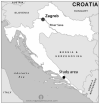Fatty Acid Composition of M. Biceps Femoris of Edible Dormouse (Glis glis L.)
- PMID: 36496805
- PMCID: PMC9735602
- DOI: 10.3390/ani12233284
Fatty Acid Composition of M. Biceps Femoris of Edible Dormouse (Glis glis L.)
Abstract
This study aimed to investigate the fatty acid (FA) composition of edible dormouse m. biceps femoris in both sexes. More than 20 FA were identified in the muscle, with the 18:1cis-9 (oleic acid) being the most abundant in both sexes, comprising more than 50% of total FA in muscle. The most dominated FA were monounsaturated (MUFA), followed by saturated FA (SFA) and polyunsaturated FA (PUFA), reaching 54.8%, 25.43% and 19.8% of total FA, respectively. Sums of PUFA and n-3 PUFA tended (p > 0.05) to be higher in males than in females. There were no significant differences between sexes on the FA composition. Nevertheless, the 18:2n-6 tended to differ between sexes (p = 0.063). Several long-chain PUFA (LC-PUFA) were detected in dormouse muscle, with the 20:4 n-6 (arachidonic acid, AA) and the 22:6 n-3 (docosahexaenoic acid, DHA) being the most abundant in both sexes. The relatively high stearoyl-CoA desaturase (SCD) indexes and the large concentration of 18:1cis-9 in dormouse muscle tissues might point to a low mobilization of the SCD products. Furthermore, finding the unusual FA 20:3 ∆5,∆11,∆14, suggests feeding on leaf and wood lipids of Coniferophytes. We demonstrated sexual size monomorphism in edible dormouse. The literature regarding the composition of dormouse meat is scarce and no studies reported the FA composition of muscle, thus, this work can contribute to increasing the knowledge on edible dormouse physiology and nutritional traits.
Keywords: Glis glis; fatty acid composition; feeding habits; m. biceps femoris.
Conflict of interest statement
The authors declare no conflict of interest.
Figures
Similar articles
-
Dietary fatty acid metabolism: New insights into the similarities of lipid metabolism in humans and hamsters.Food Chem (Oxf). 2021 Dec 3;4:100060. doi: 10.1016/j.fochms.2021.100060. eCollection 2022 Jul 30. Food Chem (Oxf). 2021. PMID: 35415688 Free PMC article.
-
Fatty Acid Composition of Muscle, Adipose Tissue and Liver from Muskoxen (Ovibos moschatus) Living in West Greenland.PLoS One. 2015 Dec 17;10(12):e0145241. doi: 10.1371/journal.pone.0145241. eCollection 2015. PLoS One. 2015. PMID: 26678792 Free PMC article.
-
Plasma fatty acid composition, estimated desaturase activities, and their relation with the metabolic syndrome in a population at high risk of cardiovascular disease.Clin Nutr. 2014 Feb;33(1):90-7. doi: 10.1016/j.clnu.2013.03.001. Epub 2013 Mar 28. Clin Nutr. 2014. PMID: 23591154
-
n-3 fatty acid enrichment of edible tissue of poultry: a review.Lipids. 2005 Feb;40(2):121-30. doi: 10.1007/s11745-005-1366-4. Lipids. 2005. PMID: 15884759 Review.
-
Nutritional enhancement of sheep meat fatty acid profile for human health and wellbeing.Food Res Int. 2018 Feb;104:25-38. doi: 10.1016/j.foodres.2017.05.005. Epub 2017 May 8. Food Res Int. 2018. PMID: 29433780 Review.
References
-
- Storch G. Gliridae. In: Niethammer J., Krapp F., editors. Handbuch der Säugetiere Europas 1, Rodentia I. Volume 187. Akademische Verlagsgesellschaft; Wiesbaden, Germany: 1978. pp. 253–263.
-
- Forenbacher S. Compendium of the Velebit Fauna. Veterinarski Fazkultet; Zagreb, Croatia: 2002. pp. 10–13. (In Croatian)
-
- Jurczyszyn M., Wolk K. The present status of dormice (Myoxidae) in Poland. Nt. Croat. 1998;7:11–18.
-
- Grubešić M., Krapinec K., Glavaš M., Margaletić J. Body measurements and harvesting dynamics of the fat dormouse (Glis glis, L.) in the mountainous part of Croatia. Acta Zool. Acad. Scie Hung. 2004;50:271–282.
-
- Konjević D., Krapinec K. Fat dormouse (Glis glis, Linnaeus, 1766), from hunting to groceries. Meso. 2004;6:59–63.
LinkOut - more resources
Full Text Sources



